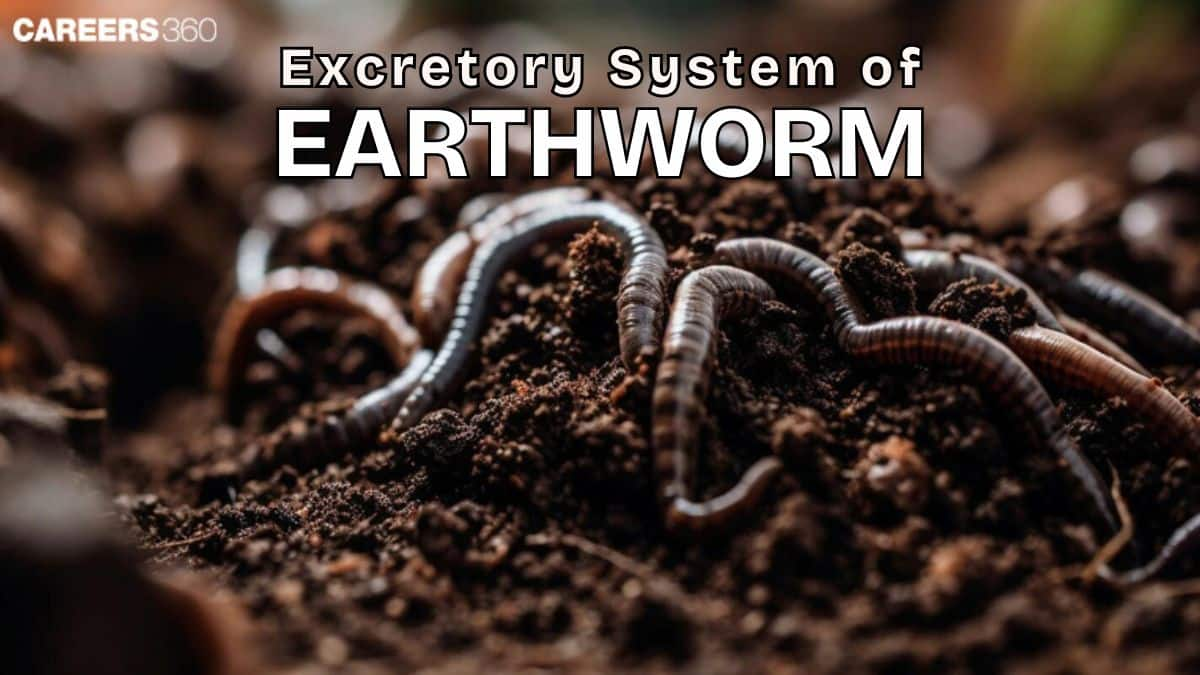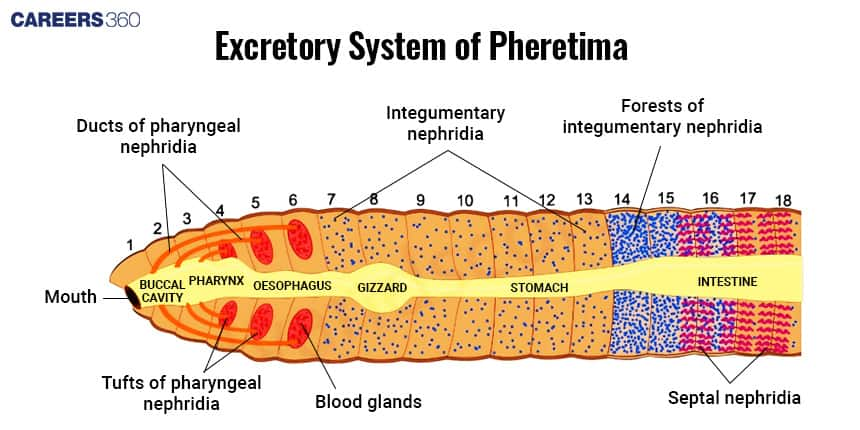Excretory system of Earthworm
The nervous system of earthworms is made up of a ventral nerve cord, segmental ganglia, and peripheral nerves, which together coordinate movement, sensory perception, reflex actions, and survival behaviours. It is an important NEET and Class 11 Biology topic under invertebrate physiology.
This Story also Contains
- What is the Excretory System of Earthworm?
- Structure of Nephridia in Earthworm
- Functions of Nephridia
- Excretory Process in Earthworm
- Adaptations for Soil Life
- Impact of Earthworm Excretion on Soil Fertility
- Comparison with Other Organisms (Invertebrates vs Vertebrates)
- Excretory System of Earthworm NEET MCQs (With Answers & Explanations)

What is the Excretory System of Earthworm?
The excretory system of the earthworm maintains homeostasis by removing metabolic refuse and controlling the balance of water in the body. The earthworms use specialized structures for excretion, called nephridia, which filter wastes from the coelomic fluid and eliminate them through the body wall. It forms a crucial part of the worms' internal environment by helping clear lethal, accumulating substances and thus assuring general health.
Structure of Nephridia in Earthworm
Nephridia are the chief excretory organs of the earthworm, acting in a fashion much like vertebrate kidneys do. It lies in each body segment and filters wastes from the coelomic fluid. There are three types of nephridia according to their location in the body.
Segmental Nephridia
These are found situated on the inter-segmental septum between 15th and 16th segments to the posterior side of the body.
Each septum bears nephridia on both the surfaces arranged in semicircles around the intestine, two rows in front of the septum and two behind it.
Each septum has about 40 to 50 nephridia in front and the same number behind, so that each segment possesses 80 to 100 septal nephridia except the 15th segment which has only 40 to 50 nephridia.
Integumentary Nephridia
In each segment of the body from 7th to the last segment, numerous nephridia are found attached inside the lining of the body wall called integumentary nephridia
These are about 200-250 in each segment except the segment of the clitellar region where they number 2,000-2,500 in each segment.
These nephridia are small-sized, without nephrostomes and without any opening into the coelom.
Pharyngeal Nephridia
These nephridia lie in three paired tufts, one on either side of the anterior region of the alimentary canal in the segments 4th, 5th and 6th.
The tufts of pharyngeal nephridia also contain blood glands.
Each pharyngeal nephridium is about the size of a septal nephridium but it is of the closed type having no funnel or nephrostome.

Functions of Nephridia
The functions of nephridia includes:
The primary function of the nephridia is to filter waste from the coelomic fluid and then excrete it through the body wall.
This process includes the removal of nitrogenous waste in the form of ammonia and urea, excess water, and minerals.
Excretory Process in Earthworm
Each segment (except the first three and the last one) bears a pair of nephridia. The primary function of the nephridia is to filter waste from the coelomic fluid and then excrete it through the body wall.
By means of cilia, wastes from the coelom are drawn into the nephrostome and tubule, transported from blood capillaries in the glandular part of the nephridium. Waste is discharged to the outside through a nephridiopore.
Role of Coelomic Fluid
Coelomic fluid plays an important role in the excretory system of earthworms.
It allows for waste products to be moved through to the nephridia for excretion, consequently efficiently removing metabolic waste products from the body.
Regulation of Water and Salts
The excretory system in earthworms maintains the body's balance of water.
Excretory systems regulate the amount of water and salts, hence the internal environment of the earthworm, and avoid dehydration.
It ensures all activities occur at their best.
Adaptations for Soil Life
The excretory systems of earthworms are specialized in maintaining efficient processing and removal of waste in a soil environment.
The functioning of the nephridia is to filter wastes out of coelomic fluid in direct contact with the soil, ensuring that there is a removal of excess water and minerals from the body.
Impact of Earthworm Excretion on Soil Fertility
Earthworm excretions play a major role in the maintenance of fertility in soils. The waste products, or castings, are highly rich in organic matter and nutrients, hence increasing fertility. They improve the availability of the nutrient content for plants and other organisms, thus balancing the ecosystem.
Comparison with Other Organisms (Invertebrates vs Vertebrates)
The excretory system of the earthworm is far less complicated than in vertebrates, but for their needs, it is very effective. It is well adapted to their lifestyle and allows these worms to thrive in moist soil environments and maintain homeostasis.
Earthworm Excretory System | Vertebrate Excretory System | |
Organs | Nephridia, which are simpler and segmented | Kidneys which are significantly complex |
Function | Nephridia removes metabolic waste products and excess substances from coelomic fluid | Nephrons filter blood, resorb useful substances and excrete waste products |
Functional Unit | Nephridia are the functional unit | Nephrons are the functional unit |
Excretory System of Earthworm NEET MCQs (With Answers & Explanations)
Important topics for NEET are:
Structure of Nephridia (Types)
Comparison with of Nephridia with Kidney
Practice Questions for NEET
Q1. The excretory system of earthworms consists of segmentally arranged coiled tubes called
Malpighian tubules
Nnephridiopores
Nephridia
Coelomic extensions
Correct answer: 3) Nephridia
Explanation:
The nephridia are tiny and coiled tubes that make up an earthworm's excretory system.
These are placed in every bodily section. Nephridia helps in preserving the water balance and eliminating waste from the body. The three forms of nephridia are pharyngeal (near the pharynx), integumentary (found in the body wall), and septal (found between body segments). To maintain the health of the earthworm, they filter waste from bodily fluids and release it outdoors.
Hence, the correct answer is option 3)Nephridia.
Q2. Pharyngeal nephridia are present as three paired tufts in _____, ______ and ______ segments on either side of the pharynx and oesophagus. Fill in the blanks by choosing the correct option.
8th, 9th, 10th
12th, 13th, 14th
4th, 5th, 6th
1st, 2nd, 3rd
Correct answer: 3) 4th, 5th, 6th
Explanation:
In earthworms, the pharyngeal nephridia occurs as three paired tufts located in the 4th, 5th, and 6th segments on either side of the pharynx and oesophagus. The nephridia open into the buccal cavity and pharynx and are responsible for the excretion of metabolic waste. These nephridia work without nephrostomes and, therefore, represent a form of enteronephric nephridia. They help regulate the composition of the body fluids as they collect extra coelomic fluid and drop the waste materials into the digestive tube for disposal.
Hence the correct answer is option (3) 4th, 5th, 6th
Q3. Integumentary nephridia are V-shaped nephridia attached to the lining of the body wall of segment 3 to the last which open outside through
Typhlosole
Malpighian tubules
Nephridiopore
Septal nephridia
Correct answer: 3) Nephridiopore
Explanation:
Certain invertebrates such as earthworms have V-shaped integumentary nephridia; these structures are among them. They run from segment 3 to the final segment and are fastened to the body wall's lining. Because they filter bodily fluids, these nephridia aid in the expulsion of waste.
The waste is eliminated through tiny holes on the outside of the body called nephridiopores. This procedure keeps the fluid equilibrium in the body and aids in the clearance of nitrogenous waste.
Hence, the correct answer is option 3)Nephridiopore.
Also Read:
Frequently Asked Questions (FAQs)
Excretion will eliminate hazardous waste and ensure homeostasis. Harmful compounds cannot accumulate in a living being; excretion guarantees health and survival.
Comparatively, the excretory system of earthworms is much simpler than in vertebrates; still, it works efficiently for their ecological niche. It is well-suited to the earthworm's lifestyle, helping it succeed in moist soil environments and maintain homeostasis.
Nephridia constitute the chief excretory organs in earthworms and function in a way comparable to vertebrate kidneys.
The nephridia filter waste from coelomic fluid and drain through the body wall, hence ridding the body of the earthworm of excess water, minerals, and nitrogenous waste products.
Coelomic fluid carries the waste products into the nephridia. In it, it is going to be excreted. This guarantees the effective clearance of metabolic wastes from the body.